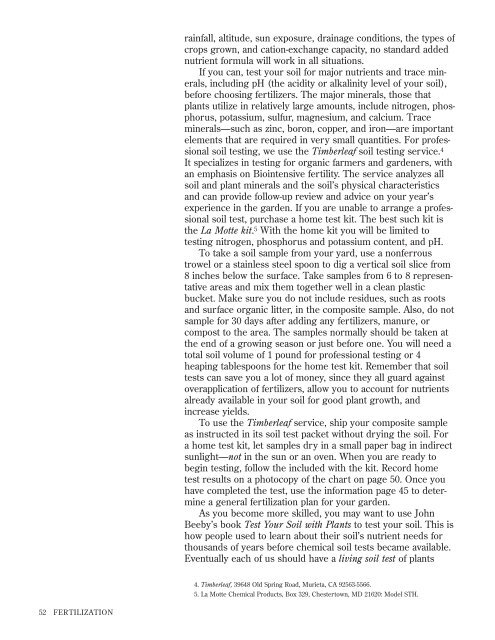How to Grow More Vegetables : And Fruits, Nuts ... - Shroomery
How to Grow More Vegetables : And Fruits, Nuts ... - Shroomery
How to Grow More Vegetables : And Fruits, Nuts ... - Shroomery
You also want an ePaper? Increase the reach of your titles
YUMPU automatically turns print PDFs into web optimized ePapers that Google loves.
52 FERTILIZATION<br />
rainfall, altitude, sun exposure, drainage conditions, the types of<br />
crops grown, and cation-exchange capacity, no standard added<br />
nutrient formula will work in all situations.<br />
If you can, test your soil for major nutrients and trace minerals,<br />
including pH (the acidity or alkalinity level of your soil),<br />
before choosing fertilizers. The major minerals, those that<br />
plants utilize in relatively large amounts, include nitrogen, phosphorus,<br />
potassium, sulfur, magnesium, and calcium. Trace<br />
minerals—such as zinc, boron, copper, and iron—are important<br />
elements that are required in very small quantities. For professional<br />
soil testing, we use the Timberleaf soil testing service. 4<br />
It specializes in testing for organic farmers and gardeners, with<br />
an emphasis on Biointensive fertility. The service analyzes all<br />
soil and plant minerals and the soil’s physical characteristics<br />
and can provide follow-up review and advice on your year’s<br />
experience in the garden. If you are unable <strong>to</strong> arrange a professional<br />
soil test, purchase a home test kit. The best such kit is<br />
the La Motte kit. 5 With the home kit you will be limited <strong>to</strong><br />
testing nitrogen, phosphorus and potassium content, and pH.<br />
To take a soil sample from your yard, use a nonferrous<br />
trowel or a stainless steel spoon <strong>to</strong> dig a vertical soil slice from<br />
8 inches below the surface. Take samples from 6 <strong>to</strong> 8 representative<br />
areas and mix them <strong>to</strong>gether well in a clean plastic<br />
bucket. Make sure you do not include residues, such as roots<br />
and surface organic litter, in the composite sample. Also, do not<br />
sample for 30 days after adding any fertilizers, manure, or<br />
compost <strong>to</strong> the area. The samples normally should be taken at<br />
the end of a growing season or just before one. You will need a<br />
<strong>to</strong>tal soil volume of 1 pound for professional testing or 4<br />
heaping tablespoons for the home test kit. Remember that soil<br />
tests can save you a lot of money, since they all guard against<br />
overapplication of fertilizers, allow you <strong>to</strong> account for nutrients<br />
already available in your soil for good plant growth, and<br />
increase yields.<br />
To use the Timberleaf service, ship your composite sample<br />
as instructed in its soil test packet without drying the soil. For<br />
a home test kit, let samples dry in a small paper bag in indirect<br />
sunlight—not in the sun or an oven. When you are ready <strong>to</strong><br />
begin testing, follow the included with the kit. Record home<br />
test results on a pho<strong>to</strong>copy of the chart on page 50. Once you<br />
have completed the test, use the information page 45 <strong>to</strong> determine<br />
a general fertilization plan for your garden.<br />
As you become more skilled, you may want <strong>to</strong> use John<br />
Beeby’s book Test Your Soil with Plants <strong>to</strong> test your soil. This is<br />
how people used <strong>to</strong> learn about their soil’s nutrient needs for<br />
thousands of years before chemical soil tests became available.<br />
Eventually each of us should have a living soil test of plants<br />
4. Timberleaf, 39648 Old Spring Road, Murieta, CA 92563-5566.<br />
5. La Motte Chemical Products, Box 329, Chester<strong>to</strong>wn, MD 21620: Model STH.












